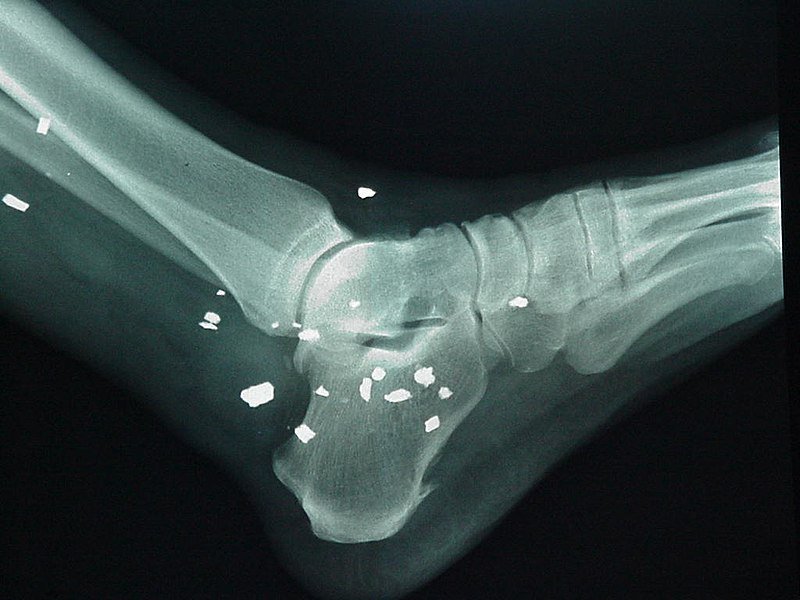Ankle Fractures and Other Ankle Injuries
Ankle Fractures and Other Ankle Injuries
 There are multiple kinds of fractures and other injuries of the ankle joint. Most ankle injuries/fractures occur in elderly women who trip and fall. Two thirds of all ankle fractures are isolated malleolar injuries. Bimalleolar fractures make up a fourth of all ankle fractures and trimalleolar fractures account for 5-10 percent of ankle fractures.
There are multiple kinds of fractures and other injuries of the ankle joint. Most ankle injuries/fractures occur in elderly women who trip and fall. Two thirds of all ankle fractures are isolated malleolar injuries. Bimalleolar fractures make up a fourth of all ankle fractures and trimalleolar fractures account for 5-10 percent of ankle fractures. The main ligaments holding the tibia and fibula together are the:
- Anterior inferior tibiofibular ligament
- Posterior inferior tibiofibular ligament
- Transverse tibiofibular ligament
- Interosseous ligament
The fibular collateral ligament is divided into three ligaments that provide lateral support to the ankle. These include:
- The anterior talofibular ligament
- The posterior talofibular ligament
- The calcaneofibular ligament
The mechanism of injury depends on the type of fracture the patient gets. A fracture usually comes from a twisting injury or a tripping injury that causes the ligaments to give way and the bone to fracture.
Clinical Evaluation of an Ankle InjuryA person with an ankle injury can present with a simple limp or may not be able to bear weight on the ankle. There can be neurovascular injury so this must be assessed at the time of injury. Soft tissue injuries and injuries to ligaments must be looked at. The entire length of the fibula should be evaluated for fracture and to assess the interosseous ligament, which can be disrupted. If the ankle is dislocated, it should be reduced immediately, even before x-rays are taken. This helps preserve the integrity of the neurovascular system around the joint.
X-rays of the front, side and mortise of the ankle should be obtained. The tibia and fibula should be measured so that there is no evidence of syndesmotic injury. If the talus is tilted more than 2 mm, there could be medial or lateral disruption of the ligaments. There should be a measurement of the talocrural angle to make sure it is the same on both ankles. The angle should be between 8 and 15 degrees.
Classification of Ankle InjuriesThere are several named classification systems of ankle injuries. For example, the Lauge-Hansen classification divides an ankle fracture into four patterns that are subdivided according to injury. There are supination-adduction injuries, supination-external rotational injuries, pronation-abduction injuries, and pronation external rotational injuries.
The Denis-Weber classification system is based on the level of the fibular fracture. There are three types of injuries in the Denis-Weber system that depend on how low or how high the fibular fracture is located. Besides these classification systems, there are multiple named fractures of the ankle that differ in appearance and treatment.
Treatment of Ankle InjuriesIf the fracture is displaced, it should be reduced in the emergency department to maintain fracture alignment. This cuts down on swelling in the post-reduction period. If the ankle is obviously dislocated, it should be reduced before x-rays are taken. Open wounds must be treated and well-padded if a cast is to be used. Follow up x-rays should be obtained after a bulky posterior splint is applied and after reduction of the fracture. This helps identify any remaining areas of dislocation. Ice and elevation can help after reduction of the ankle.
Non-operative repair of the ankle fracture can be done if the ankle is stable and non-displaced. The syndesmosis between the tibia and fibula must be intact. If stable reduction can be achieved in displaced fractures, surgery may not be necessary. A short leg cast or removable boot can be used to maintain alignment of fracture segments. Weight bearing can be allowed as tolerated with the boot in place. If the fracture is displaced and reduced in the emergency department, then a bulky posterior splint may need to be applied to the ankle for a few days to reduce swelling before a cast or boot is used. Long leg casts might be necessary to avoid rotation of the ankle. Serial x-rays must be undertaken to make sure the fracture is healing.
Surgery to the ankle is used for those fractures that fail to reduce via closed mechanisms. Open reduction and internal fixation can be done after the swelling goes down and soft tissue is healing. Screws or Kirschner wires can hold together the lateral malleolus (the outer bump on the ankle). Medial malleolar fractures can be stabilized using tension bands or screws. Fibula fractures above the tibial plafond (the base of the tibia) may need stabilization of the ligament that holds the fibula and tibia together. After the fracture is fixed, a bulky splint can be applied with gradual progression to weight bearing.
Open fractures need to be irrigated immediately in order to avoid infection. Dead tissue must be removed and external fixation might need to be necessary so that the wound can be observed and periodically debrided.
Complications of Ankle InjuriesThere can be non-union of the fracture, but this is rare. Malunion can occur, which involves shortening of the lateral malleolus and rotation of the ankle. There can be wound problems, infection, posttraumatic arthritis, reflex sympathetic dystrophy, compartment syndrome of the foot, synostosis of the talofibular ligament, and loss of reduction of the fracture.
Sacramento Traumatic Injury LawyerI’m Ed Smith, a Sacramento Traumatic Injury Lawyer, who has handled many serious ankle fractures from trauma. Call me anytime for free, friendly advice at 916.921.6400 in Sacramento.
We are members of the Million Dollar Advocates Forum and the National Association of Distinguished Counsel.
See our client reviews on Avvo, Google, and Yelp, and our past cases on our Verdicts and Settlements page.
Editor’s Note: This page has been updated for accuracy and relevancy [cha 10.13.20]